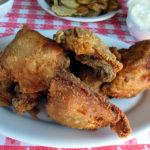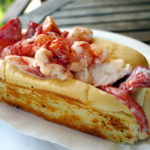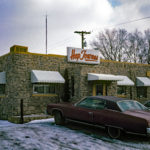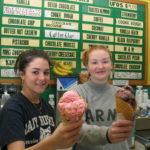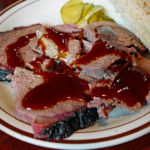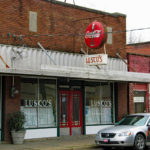Perch Palaces
Northwest Indiana, between the Illinois border and the old steel mills of Gary, is a marvelous place to eat. Before factory soot stained the air and before the flatlands were webbed with train yards, this waterfront enclave was a favorite retreat for sport fishermen, and the best meals around were probably those they cooked at twilight after a good day's catch. Today, epicures travel from miles away to restaurants on the south shore of Lake Michigan in Indiana, where dinners of freshly caught lake perch are the specialty of the house.
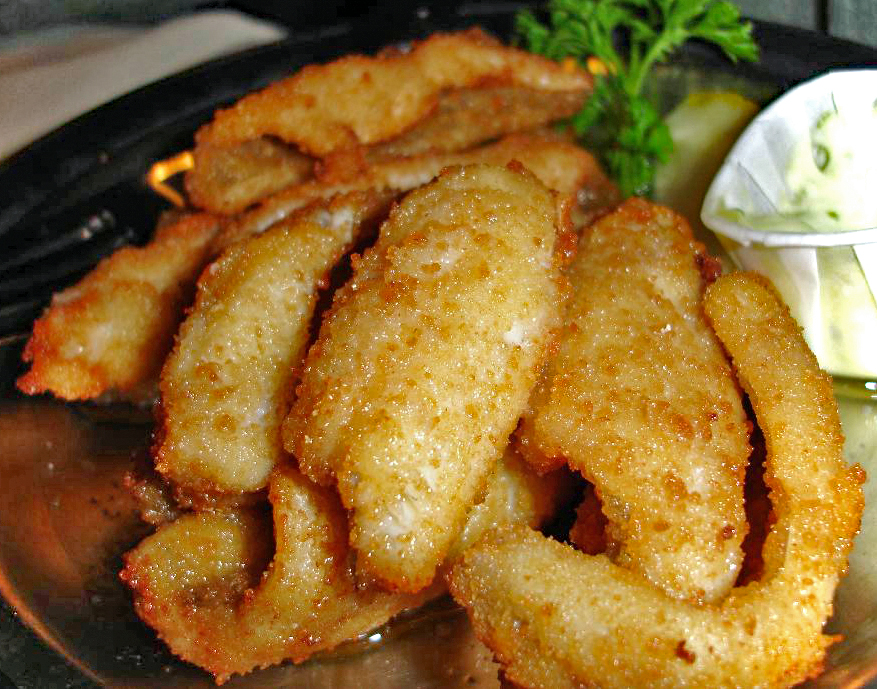
By Jane and Michael Stern
Originally Published 1995 Gourmet Magazine
Northwest Indiana, between the Illinois border and the old steel mills of Gary, is a marvelous place to eat. Before factory soot stained the air and before the flatlands were webbed with train yards, this waterfront enclave was a favorite retreat for sport fishermen, and the best meals around were probably those they cooked at twilight after a good day’s catch.
Today, epicures travel from miles away to restaurants on the south shore of Lake Michigan in Indiana, where dinners of freshly caught lake perch are the specialty of the house.
The small panfish are cooked the way fishermen have always prepared them: lightly dipped in seasoned flour and fried in a skillet. Lake perch are firm little sweeties, and they remain intact as their skins crisp in the pan and become fragile, translucent envelopes around the fine meat. A handful of these comely fish make one serving. In the dining rooms of Lake County, Indiana, you have your choice of ordering them either whole or boned, plain from the skillet or drizzled with melted butter. Old timers bone their own. If you are not an experienced hand at extricating fish skeletons, it can be a considerable amount of work for not a lot of meat; but there are purists who contend that a fish begins losing savor as soon as it is filleted, and they want no time at all to pass between boning and eating. As for butter, it is definitely a proper complement to the perch—if you do order them boned and buttered, the fillets arrive swimming in a warm, golden pool.
Any way you choose to have your lake perch, the fish is one of the heartland’s great regional delights. Although the flesh is firm and compact, it flakes into tiny segments with a tantalizing, dainty texture. Drawn butter wants to seep into its crevices, but even if you get it without butter and merely apply a squeeze of lemon the fish is intrinsically luscious. Juicy, gentle, and clean on the tongue, it is totally unlike ocean flatfish. It fairly glows with a freshwater sparkle that makes you think of summer breezes, wooded shorelines, and the sizzle of a day’s catch over a crackling campfire.
The joy of eating perch along Lake Michigan’s south shore includes not only the sublime taste of the fish itself but the ritual meal in which it stars. Five relishes begin the banquet, lined up in five dishes with five serving spoons: cottage cheese, pickled beets, potato salad, coleslaw, and kidney bean salad. Many customers accompany the relishes with highballs of the old school: neat Martinis with olives, sweet Manhattans with maraschino cherries, Tom Collinses, and Rob Roys. You can order a starter, but it’s probably wiser to focus your appetite on the main attraction. One plate of boned perch is anywhere from six to ten fillets, depending on size, which is a nicely portioned meal; but the restaurants that specialize in it customarily provide an opportunity to eat more. They offer either a free second helping or the option to pay a surcharge and eat perch until you decide you have had enough.
Also crucial to the appeal of the meal are the places in which it is served. Going out for perch in Northern Indiana is a strange experience, a night of gastronomic indulgence that seems in some ways lavish, yet has all the personal charm of frequenting a favorite street corner coffee shop.
In particular, we are referring to a couple of restaurants less than a mile apart: Phil Smidt and Son, in Hammond; and Vogel’s, in Whiting. They serve their meals on thick china spread across soft tablecloths in majestic dining rooms designed to accommodate sybarites. They are two of the most unusual eateries in America, and some regular patrons drive from hundreds of miles away to relish their unique Great Lakes feast, which has remained unchanged for decades.
The landscape all around the restaurants has changed dramatically since Phil Smidt started serving perch dinners to local fishermen in 1910. The quiet sportsmen’s paradise by the shore was transformed by commerce and industry into one of the most brawny urban environments in the land. By mid-century, Hammond, Indiana, was lit up round the clock with smelters shooting flames into the sky. In the last twenty years, that too has changed. Many of the great factories have succumbed to industrial senescence. The steel mills and oil companies of Gary are ghosts of what they used to be. Many of the smokestacks, steel girders, and oil tanks that crowd the horizon appear to be crumbling or at least down at the heels. But if you lower the windows of your car and inhale, you will know that this is still a part of the world where raw materials are melted, fused, molded, and cast to make things. The air is thick with the sulfurous smell of factory emissions, and freight trains trundle along tracks pulling boxcars full of wares, tank cars of chemicals, and flatcars with heavy equipment strapped aboard. When you cruise off the Chicago Skyway onto the 106th Street exit and down along Indianapolis Boulevard, the vast American Maize plant fills your nostrils with the aroma of corn processing. It is an acrid smell, like corn on fire, but in some perversely appealing way it is also syrup-sweet.
Just south of American Maize is VOGEL’S, a restaurant sized to fit its neighborhood: 850 seats altogether in five dining rooms plus a few meeting halls and lounges. A sign out front is an icon of the fine dining that awaits. It says RESTAURANT LOUNGE and shows a stylized Martini glass, with an olive inside, next to a big, thick steak and a knife and fork. In the parking lot, a movable letter sign reads “Perch the way you like it.” When you step out of your car here, you smell nothing but clean air. Very clean air. That’s because across the street from Vogel’s is one of the largest factories in the area—several blocks of blond brick wall many stories high—the Lever Bros. soap factory. The fumes from the factory cleanse the neighborhood’s atmosphere and leave it as perfumy as the inside of a busy laundromat.
Vogel’s possesses one of the greatest restaurant entrances anywhere. It is positively ceremonial, staged to separate you from the gritty industrial exterior and make you feel certain you have found a world where luxury reigns. Reminiscent of the original Fontainebleau hotel in Miami Beach or Caesars Palace in Las Vegas, its scale is immense, and the enthusiasm of its interior decor knows no bounds. Past the vestibule, where twelve wall sconces glow with the signs of the zodiac, the lobby is positively cavernous. It is a long walk across the carpeting to the hostess’s station; but, when not swamped with customers, the hostess will come out and meet you halfway, then guide you to the Parisian Room, the Crown Room, the Gold Room, the Aegean Room, the Petite Room, or the Viking Bar. There are oil paintings all around the lobby: romantic landscapes signed “Ellen Vogel,” formal portraits of founders Fred and Ida Vogel, and one remarkable picture of Robert Vogel (Fred’s son) holding a cake shaped exactly like the original Vogel’s restaurant above another cake shaped exactly like the current one.
Near this picture, in and around a stairwell leading to the downstairs lavatories, are some of the taxidermied animals Robert Vogel has shot: a whole standing Alaskan brown bear, a mountain lion about to pounce, a water buffalo (head only), a zebra (head only), and dozens of trophies of deer and smaller game. A rope prevents gawkers from touching the lion, but, if you get close, a hidden treadle under the rug triggers a frightening canned roar.
Vogel’s perch, whole or boned to order, is radiant: firm, sweet fleshed, and enrobed in a chewy thin skin of seasoned crust. The whole ones are impeccable, and the better choice if you have patience to work for your supper. Lightly cooked in the pan, the fish emits little puffs of buttery steam when you separate the meat from the bones. The fillets are fine, too: pan-cooked, then boned and buttered just moments before they are served six to eight on a plate. If eight aren’t enough, don’t worry: The price of dinner includes another plateful.
Shrimp De Jonghe is another glorious specialty: big, pink, peeled shrimp “en casserole,” the shrimp blanketed in an — elemental paste of bread crumbs, garlic, butter, and Sherry and served on four toast points. Shrimp De Jonghe is not native to Hammond; it is a Chicago invention, created early in this century by Pierre de-Jonghe and/or Emil Zehr (there is still some debate), chefs of the deJonghe restaurant on Monroe Street. Prohibition forced the deJonghes to sell the business (and temporarily left their recipe in limbo, as it requires Sherry), but the dish remains one of Chicagoland’s best treats. We can think of no better place to savor this hearty helping of local culinary history than a table at Vogel’s.
All the recipes at Vogel’s are old ones, many going back to Ida Vogel’s days as a boarding-house cook in Hammond before World War I. After the war, newlyweds Ida and Fred opened their own boarding-house saloon in town. “The boys from Standard Oil lived upstairs,” Robert Vogel recalls. “Mother cooked for them, and they got their drinks from Dad.” The Vogels opened their first restaurant in 1921, specializing in perch and catering to the duck hunters and fishermen who used to go camping in the area. As industry grew, so did their business. “In the early 1940s, my dad said, `I’m going to, build a building I won’t ever have to remodel or enlarge,'” Robert Vogel says; and despite wartime lumber shortages Fred Vogel managed to open his giant new place in the current location. Robert, who started working in the restaurant when he got out of the service in the mid-1940s, remembers customers crowding in for lunch as soon as the twelve o’clock whistle blew in surrounding factories. In 1960, eight years after his father died, Robert Vogel transformed the restaurant into the swank supper club it is today, honing the dramatic Continental flair that makes Vogel’s such a delirious example of pre-Panisse epicurean style.
The first neighborhood restaurant to make perch a specialty was PHIL SMIDT & SON. Smidt’s is around the corner from Vogel’s, near the new Hammond Marina, where shipside gambling is soon supposed to revive the local economy. The story told about Mr. Smidt is that he was on a train heading West from New Jersey, hoping to find his fortune in California. He got off in Hammond thinking he was already in Chicago, at the end of the line, and the train left without him. Making the best of his situation, he opened a small bar and grill specializing in chicken dinners and perch brought in by his customers. A photo of the original place taken some time in the 1920s shows rugged looking males gathered around a table where they have more than enough beer mugs to accompany their food. A sign above them warns NO DANCING, NO VULGAR TALK.
Phil Smidt’s decorative motif is roses—big pink ones on the walls, the glassware, and embroidered on the waitresses’ aprons. Michael Probst, who took over the restaurant in 1980, after Pete Smidt, Phil Smidt’s son, had left, says, “I think if I even touched the roses, God would strike me dead. People love them.” Probst went to restaurant school in Europe, but grew up nearby. “I was born twenty miles from here, but I never dreamed I would own this place. In some ways I still don’t really feel I own it, because so many of our customers believe they own it. They’ve been coming that long. We have had five generations of a family at one of our tables.”
Frogs’ legs have been on the menu since the 1930s. Frogs’ legs in Northern Indiana? Yes, indeed; second only to perch, they are a local passion. In fact, the Chicago Tribune once speculated that Hammond might be the “frog leg capital of the world.”
At Phil Smidt’s, the frogs’ legs are ravishing. They are available either deep-fried or sautéed, as a starter or as a meal. The fried ones are tasty, but the exquisite texture of the meat can get lost in their crunch. Sautéed legs are tender and refined, and they arrive awash in butter on a small silvery platter. “A few years back, we had a lady who drove here from Buffalo, New York, just because she wanted our frogs’ legs,” Mr. Probst recalls. “Her husband didn’t particularly like frogs’ legs, so he ate steak. They spent their vacation here in Hammond so she could eat her fill.” Now, if the Buffalo lady (or anybody else who lives far away) craves frogs’ legs, Phil Smidt’s has installed a toll-free number and will ship them overnight, ready to eat, anywhere in the United States, including Alaska and Hawaii. The number is (800) FROGLEG.
The best thing to eat here, of course, is the classic meal Mr. and Mrs. Smidt developed eighty-five years ago: a mess of perch preceded by five relishes. (A single-serving perch dinner costs about eighteen dollars, boned fish are a dollar more, and for an extra six dollars you get all you can eat.) Although Phil Smidt’s recipes for mustard flavored potato salad, marinated kidney beans, crunchy coleslaw, and zesty pickled beets are closely guarded secrets, you shouldn’t expect surprises; the charm of these appetizers is their familiarity. They herald comfort food and a hearty meal without pretense. The boned and buttered perch is one of the handsomest sights you will ever see on a pink-rimmed china plate. Ten or so elegant fillets, firm and fresh and rosy, glisten inside their diaphanous golden crusts. They are arrayed in a line with their fragile skins up, so the meat down below can soak up maximum amounts of melted butter. It’s bliss!
Phil Smidt & Son (permanently closed)
1205 North Calumet Avenue
Hammond, Indiana
Vogel’s (permanently closed)
1250 Indianapolis Boulevard
Whiting, Indiana
Discuss
What do you think of Perch Palaces?
Related Articles
Stroud’s
By Jane and Michael Stern Originally Published 1995 Gourmet Magazine Chicken...
The Lobster Roll Honor Roll
Maine is the only state in America that features a picture of cooked food on its license...
Meat-And-Three
A few years back, country singer Ray Stevens invited a New York friend to join him at one of...
Top 12 favorite Ice Cream Scoops
WITH THE EXCEPTION of the hot dog bun, there has never been an edible invention as...
Top 5 BBQ Restaurants | Western Kentucky
Get yourself to Western Kentucky for great BBQ I see the food shows on TV where...
Best restaurants in Greenwood, MS | Hot Licks Delta Style
Ever since we first ate margarine-sauced pompano at Lusco’s, in Greenwood,...

